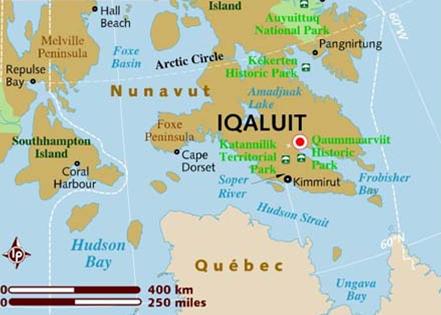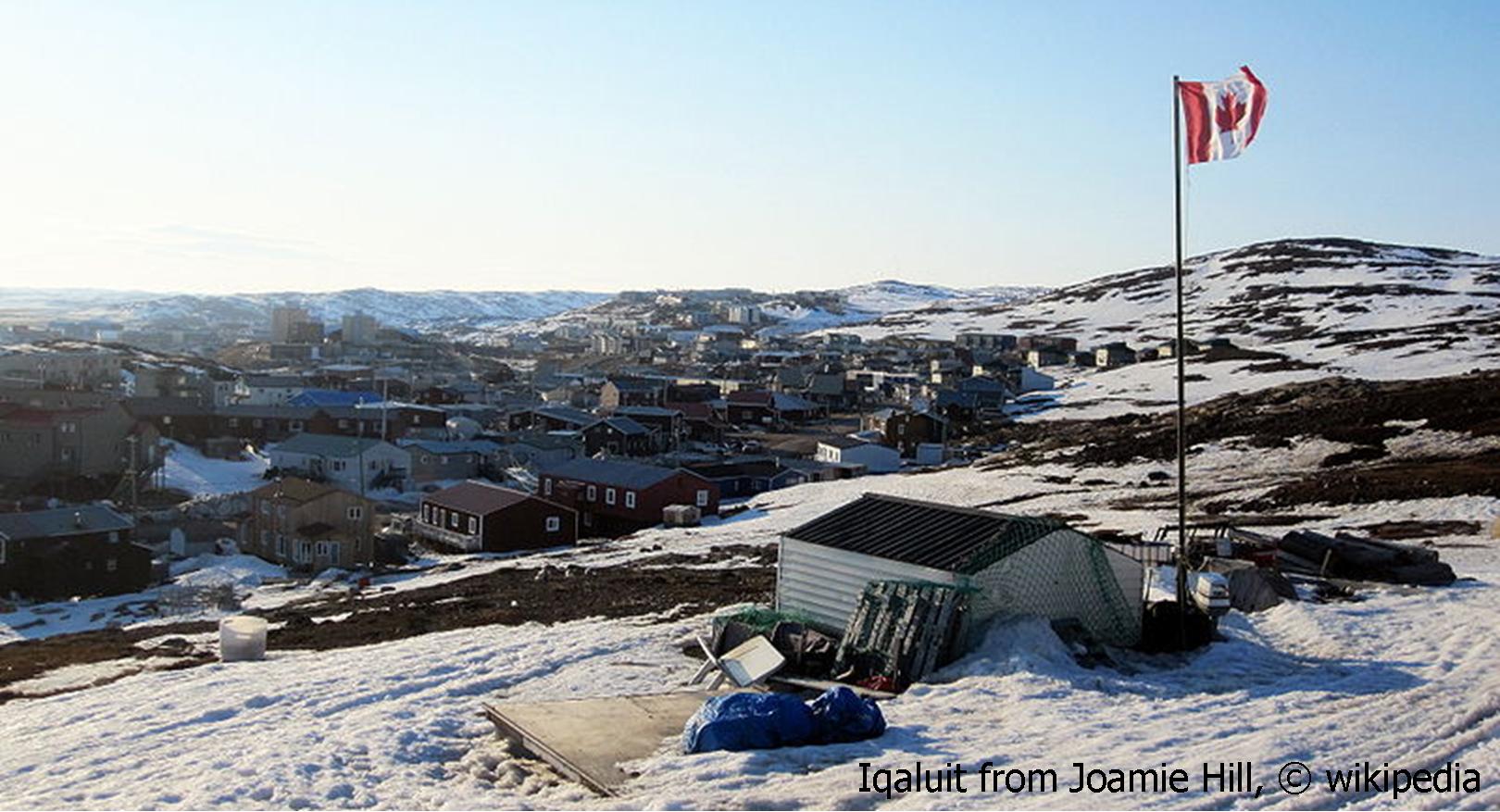
Environmental
 Iqaluit, Canada's most northern capital of the territory of Nunavut, is located on the head of Frobisher Bay overlooking Koojesse Inlet on the southeastern coast of Baffin Island. Iqaluit, once known as the community of Frobisher Bay, is the largest community in Nunavut with a population now of more than 7,250 (2010 estimate). Iqaluit means “the place of many fish” in the Inuktitut language of the native Inuit people. Iqaluit originated as a Second World War military airfield, however. the airfield was never fully used for its intended purpose as a refueling base for short-range military aircraft en route from America to Great Britain. Today the airfield is the cornerstone of the city of Iqaluit as it has opened the region to development during the postwar years. Iqaluit has subsequently become a key transportation and communication hub for the eastern Arctic.
Iqaluit, Canada's most northern capital of the territory of Nunavut, is located on the head of Frobisher Bay overlooking Koojesse Inlet on the southeastern coast of Baffin Island. Iqaluit, once known as the community of Frobisher Bay, is the largest community in Nunavut with a population now of more than 7,250 (2010 estimate). Iqaluit means “the place of many fish” in the Inuktitut language of the native Inuit people. Iqaluit originated as a Second World War military airfield, however. the airfield was never fully used for its intended purpose as a refueling base for short-range military aircraft en route from America to Great Britain. Today the airfield is the cornerstone of the city of Iqaluit as it has opened the region to development during the postwar years. Iqaluit has subsequently become a key transportation and communication hub for the eastern Arctic.
The temperature in Iqaluit in January averages -30°C, and in July it is 15°C. There are nearly 24 hours of daylight per day in June whereas in December there are 6 hours of daylight per day. The long cold winter begins in September and the ground is usually snow covered until June. July and August are the summer months.
Climate data for Iqaluit

Source: Environment Canada (2009)
The picturesque Sylvia Grinnell River is just a 30-minute, one kilometre walk from Iqaluit. There are ancient Thule archaeological sites, a variety of rare plants, several species of wildlife and some 40 species of birds. Key environmental factors include permafrost and ground ice, but also surface hydrology, sea ice, drifting snow, storms and flooding hazards. The macrotidal setting creates spectacular tidal flats and challenges for shipping. Climate change is imposing changes in a number of species, including seals, which are among the most important country food besides fish.
Economic
In Iqaluit, dominant economic factors include the territorial and federal government offices, denoting its place as capital of the Nunavut territory and the airfield and coastal port, denoting its postion as a transportation hub. The harvest of country food is also important to the local economy. Economics around this mainly cultural activity include fishing, sealing, and trapping. Tourism and the making of local crafts are gaining in importance as related economic and cultural activities.
Social
Inuit represent approximately 85 per cent of the population and Inuktitut is the dominant language, with 60 per cent of Nunavut residents speaking it at home compared to about 35 per cent for English. In Nunavut, a high population growth rate over the past several years has resulted in the territory having the youngest population in Canada. Approximately 60 per cent of the population are under 25 years of age (92 per cent of whom are Inuit) and 41 per cent of the population are under 16 years of age.
Although the airport provides transportation into the community, ground transportation in Iqaluit is limited to snowmobiles and all-terrain vehicle as there are few roads in Nunavut. Larger shipments are mainly transported by barge or cargo plane.

Cultural
Most government documents in Iqaluit are translated into English, French, Inuktitut and Inuinnaqtun (a western Arctic Inuit language). Inuit culture is woven into daily life and 'Inuit Qaujimajatuqangit', or local indigenous knowledge and values, is considered a "guiding principle of public government.
Local outfitters offer a wide variety of trips to the Qaummaarviit Territorial Historic Park, which is rich in archeological artifacts dating back to the Thule culture. Iqaluit also hosts a number of festivals and activities. The Snow Challenge is a snowmobile race from Iqaluit to Kimmirut and back that takes place in March. In April, celebrate the spring at Toonik Tyme, a weeklong festival of traditional Inuit activities. In June, enjoy the Nunavut Arts Festival, and Alianait!, the newly formed multicultural arts festival that a variety of film events, art displays, theatre productions, and concerts.
May 2010 © C-Change Secretariat (Canada) & C-Change Partners for Iqaluit.
Community Links




























